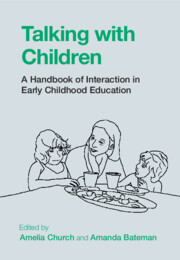Book contents
- Talking with Children
- Talking with Children
- Copyright page
- Dedication
- Contents
- Figures
- Tables
- Contributors
- Acknowledgements
- Notes on Transcription Conventions
- Introduction
- Part I Talk as Social Action
- Part II Pedagogy in Interaction
- 8 Literacy
- 9 Storytelling
- 10 Digital Technologies
- 11 Mathematics
- 12 Creativity
- 13 Multilingualism
- 14 Belonging
- Part III Interaction and Inclusion
- Index
- References
11 - Mathematics
from Part II - Pedagogy in Interaction
Published online by Cambridge University Press: 16 June 2022
- Talking with Children
- Talking with Children
- Copyright page
- Dedication
- Contents
- Figures
- Tables
- Contributors
- Acknowledgements
- Notes on Transcription Conventions
- Introduction
- Part I Talk as Social Action
- Part II Pedagogy in Interaction
- 8 Literacy
- 9 Storytelling
- 10 Digital Technologies
- 11 Mathematics
- 12 Creativity
- 13 Multilingualism
- 14 Belonging
- Part III Interaction and Inclusion
- Index
- References
Summary
Early childhood educators are faced daily with supporting young children’s learning in educational environments that include digital technologies. This chapter first discusses what is currently known about young children’s use of digital technologies from health and educational perspectives. Specifically, this chapter shows how young children’s digital technology use in early childhood classrooms is influenced by a range of factors, such as access to digital technology and educator beliefs about the benefits of technology, and how to integrate digital technology in ways that align with early childhood pedagogy. Next, this chapter shows how educators and children engage with digital technologies through employing interactional practices that support inquiry-based learning, problem solving, and conceptual engagement, including digital and critical literacy skills. In this way, it highlights how teacher pedagogy-in-use makes possible children’s rich engagement with digital technologies. Finally, this chapter shows how these understandings are be applied by educators in their own practices.
- Type
- Chapter
- Information
- Talking with ChildrenA Handbook of Interaction in Early Childhood Education, pp. 227 - 246Publisher: Cambridge University PressPrint publication year: 2022



